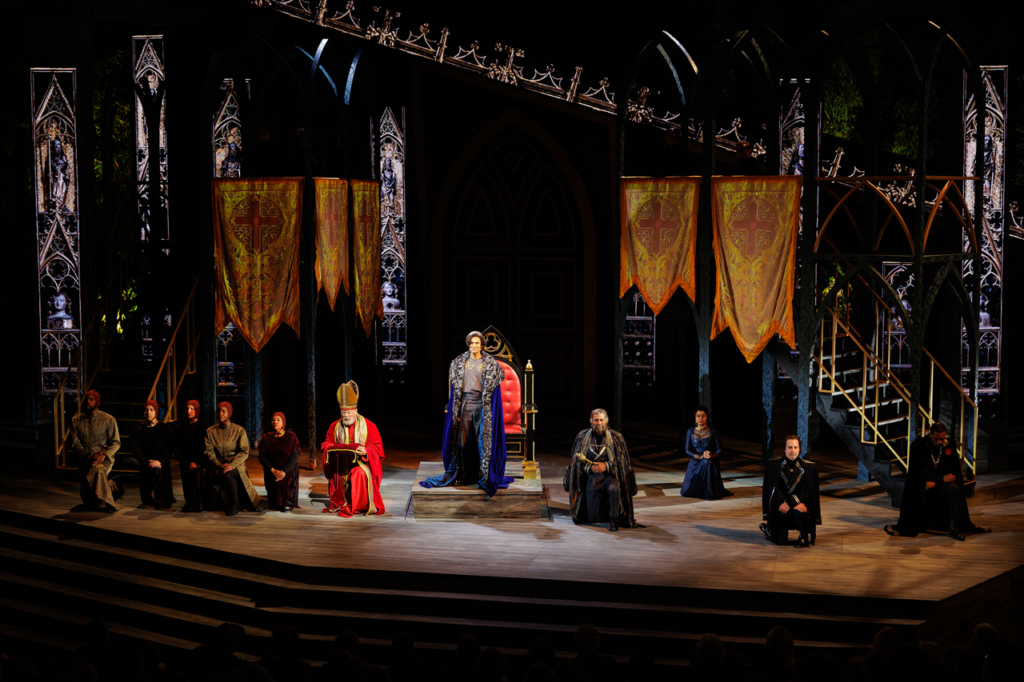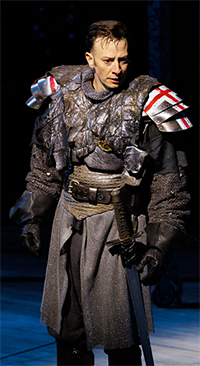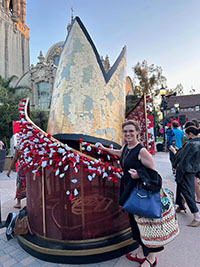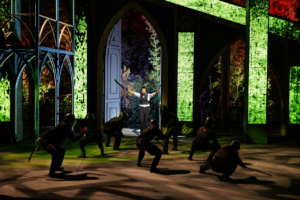
By Sandi Masori


SAN DIEGO — Play. Production. Spectacle. Event. None of these words adequately describe The Old Globe’s current show Henry 6 for it is all of these things. A first for me, the play is presented in two-parts, over two-days. Each play is about 2.5 hours including intermission.
But it’s more than just a play, for the experience starts when you walk up to the area surrounding the Old Globe. Besides the usual step-and-repeat banner ready for selfies, there are banners hung all around the square, and a huge crown installation in the center.

At a table near-by, guests are directed to make a fabric rose, either red or white, and add it to the base of the giant crown. They are then offered a rose pin to wear.
The reason for such a to-do? This production marks a pretty significant achievement, in that it completes the Shakespeare canon for the Globe, meaning that over the course of its history, The Old Globe has produced all of Shakespeare’s plays, thereby joining a very small club of theaters that have done so.
When you enter the outdoor theater, you are greeted with some Shakespearean style scaffolding that becomes the towers and castles throughout the show. Lawrence E Morton III’s set is minimal but very effective and the natural backdrop of the trees in Balboa Park merges beautifully with the design. Long LED screens embedded in the columns around the stage add color and texture. There is an elevator that comes up in the middle of the stage that has a central piece of furniture like a bed, a throne, or a pedestal, and other than that, it is the actors and the dialogue that set the scene.
(As a side note: If you’ve never been to the Globe’s outdoor theater before, the seating is stadium-style with plastic chairs, so you may want to bring a seat cushion and a wrap or a blanket.)
The usual three-part play is divided into two acts: One: Flowers and France, and Two: Riot and Reckoning. As noted above, each part is delivered on a different day.
To very quickly sum up both parts, in Part One we see baby King Henry 6 ascend to the throne. With a baby king and no strong leader, the court is thrown into chaos as the young king gets advice from various factions with their own agendas. His father had conquered France, which then rallies behind Joan of Arc to fight to get their land back. King Henry 6 (Keshav Moodliar) marries Margaret (Elizabeth A. David) who, with an agenda of her own, stirs up more trouble. In the meantime, trouble is brewing between the houses of York and Lancaster.
In Part Two, the trouble between York and Lancaster becomes a War of the Roses with the King Henry 6’s house of Lancaster represented by the red rose and the usurping house of York represented by the white rose. Death and destruction follow.
Besides the main cast, several of whom die in Part One but come back as another character in Part Two, this production made use of 1,000 (yes, 1,000) San Diego community members in one way or another. Some may have a walk-on role, others were filmed to be part of the ever-changing face of the oracle, still others were part of various workshops that designed pieces and inspiration for the props used, and still others help with some of the tech, making this truly a community production.

And while it is a serious show, you get the feeling that director Barry Edelstein was having fun. This comes out in some of the more playful touches, like the anachronistic video oracles, who wear modern clothes and glasses, or the opening of Part Two which has actor Tally Sessions (who is phenomenal and an absolute standout even among this star-studded cast) playing rebel Jack Cade wearing a costume that looks very much like the “shaman” of Jan 6, 2021. To drive the point home, he even asks the name of one of his followers, and when the follower says his name is Brandon, he leads a little “Let’s go Brandon” chant, which I’m fairly certain was not in the original script.
Part One is a little more serious and less anachronistic, but the touches are still there, like Queen Margaret’s very modern boots, or the Duke of York’s (William DeMeritt) PowerPoint presentation on why he should be king.
The casting seems to be both color-blind and gender-bending in that you have women playing soldiers, dukes and princes. While the color-blind casting worked really well, the gender-bending casting at times makes it a little confusing to figure out who’s who – especially for the bit parts where some actors play multiple roles. It took me a minute to figure out that Joan of Arc (Cassia Thompson) was Joan of Arc and not another gender-bent soldier. Thompson does an incredible job as Joan in Part One. In Part Two she also plays Prince Edward, which is a little more confusing.
As mentioned earlier, Tally Sessions delivers two standout performances, as Lord Talbot in Part One, and Jack Cade in part two. In both shows his character dies within the first 15-minutes, and I mourned the loss of the actor on each stage, fervently wanting to see more of him. He plays the two characters so well and so differently that I was wishing he had had a longer role in each, and judging by the roar both nights when he came out to take his bow, I’m thinking I wasn’t alone in that.
Moodliar’s young King Henry is a lot of fun, his playful body language brings a lot of whimsy to the young king. Later in Part Two that whimsy is notably missing as the character becomes more lost and the conflict spirals out of his control. Moodliar expertly handles the transition from young to old and is captivating to watch.
Sofia Jean Gomez plays the gender-bent Earl of Warwick to great effect. Her performance does justice to the character and in this case, the gender bending does not distract.
Other stand-outs are Mike Sears as the cardinal in Part One, Thompson as Joan, DeMerritt as Richard Plantagenet (Duke of York), and Gregg Mozgala in both his roles as Suffolk in Part One and Richard, son of York in Part Two. Mahira Kakkar also shines in her many parts, but I particularly liked her as another gender-bent character, Alexander Iden in Part Two.
I could go on and on, but in order to keep this review shorter than the play(s) itself, we can sum it up to say, it’s an entire experience, and though it’s one of the more serious Shakespeare history plays, the overall experience is a fun one.
Part One plays through September 14, and Part Two through the 15th.
*
Sandi Masori is a theater and restaurant reviewer for San Diego Jewish World.